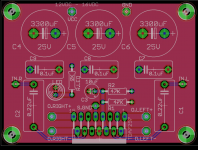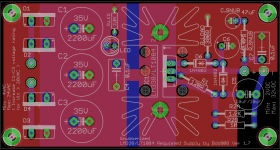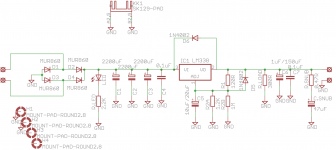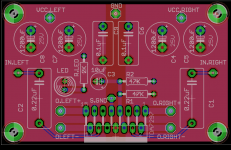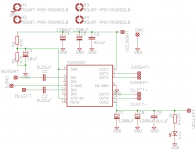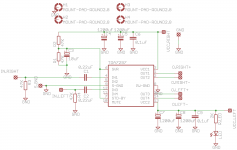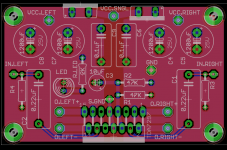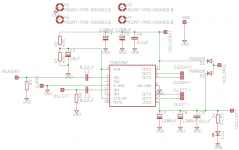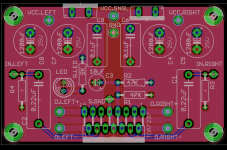For my very specific setup I've found the opposite - but then they are inexpensive enough it was fun to try both.TDA7297 sounds good but tpa3116 sounds, to me, better.
I have never taken much notice of specs. or test tones, especially ones below the threshold of normal hearing (20hz), for me it's the music.I don't think it's an issue of enough drive or current from the TDA7297. I've easily exceeded 95dB SPL in my listening room with plenty to spare. As I pointed out before, the frequency response of the amp itself is not flat down to 20Hz. This is clearly cited on the datasheet and I verified it in my listening room with a sound meter and test CD. That said, I still really like the TDA7297 and I would recommend it to people who don't like the Class D amps for whatever reasons, but still want a great-sounding budget amp. In fact, I like both amps than many more expensive amps I've heard, SS and tubes. It basically just comes down to personal preference. Some will like it more than the TPA31xx Class D amps, and some won't. To my ears, these amps are more similar than different.
I have always had large speakers and have never been able to get them to produce a 30hz test tone that I could hear, even when I was 30 years old. Hearing my big old 15 inch speakers producing the kick drum on the beginning of Dire Strait's Money For Nothing, is just wonderful. It's all about overtones and tightness rather than Whoompy one note bass, for me, anyway.
Due to the big freeze up here I have not left the house for a week and have been listening for long periods to music with the stock 7297 and I could not wish for better.
I have not given up on the d amps that I have purchased, including the tpa3116, but I was very disappointed that they all produced EMI that ruins my fm radio reception. I did not audition them too seriously because I did not want to give up 30% of my listening. I have ordered a bunch of ferrite beads that I will clamp on all the cables and see what happens.
I'm happy with the tda7297 and tda7294 A/B amps I have, and would not use the switching amps unless I want some sort of battery portability.
My speakers are Fostex FE207E + FT17H in MLTL. 95-6db . Very efficient.The 7297 is only 15 watts/channel @ 10% THD, so require very efficient speakers to operate well at .1% THD which is about 8W/ch
If you have modern, 4ohm inefficient speakers then the 3116 will sound better.
My speakers are Fostex FE207E + FT17H in MLTL. 95-6db . Very efficient.
I like both amps but from my experience of now using many examples of each of these boards with many different sets of speakers, I think the better the speaker, the more obvious the better performance of the 3116 is, regardless of efficiency.
I like both amps too. I prefer 3116 a bit more.
I just did some "quick and dirty" measurements using "Room EQ Wizard", and the voltage divider trick from:
Speaker signal to line level
plus I had to use a PA "di box" (has a transformer) to isolate the ground from the input as the -ve speaker output on the TDA7297 isnt tied to ground.
This is may not be a complete measurement as I would use a TPA3116 at higher voltage typically, but I tried to match the two amps as close as possible including driving them both from a 12V battery.
Soundcard used was a behringer UCA-202.
I used a 27K & 1K resistor as the voltage divider on the output to get the output from the amp.
I connected the amps to Alesis Monitor One speakers so both were driving a realistic 8 ohm speaker load.
Volumes matched using a stepped attenuator, plus some fine adjustment on the volume control of the TPA3116 so I had the volumes matched as close as possible.
I have shown the "Room EQ Wizard" THD distortion graph - for those not familiar it shows the fundamental + total response at the top, then the THD, below that the 2HD, 3rdHD, etc as different colours. The numbers displayed in the screenshots are the distortion values at the value where the cursor is - which for this set of screenshots is 7Khz, i.e the numbers at the bottom are for 7khz, not overall.
TPA3116
http://pix.minirig.org.au/main.php?g2_view=core.DownloadItem&g2_itemId=5850&g2_serialNumber=1
TDA7297
http://pix.minirig.org.au/main.php?g2_view=core.DownloadItem&g2_itemId=5855&g2_serialNumber=1
running the soundcard "loopback" output to input to give a baseline:
http://pix.minirig.org.au/main.php?g2_view=core.DownloadItem&g2_itemId=5860&g2_serialNumber=1
(0.02% THD, not too shabby)
running the soundcard + old Leem DI box loopback:
(this added a bit of grunge but still I dont think affected the results too much)
http://pix.minirig.org.au/main.php?g2_view=core.DownloadItem&g2_itemId=5845&g2_serialNumber=1
pic of some of the "measurement gear" setup:
http://pix.minirig.org.au/main.php?g2_view=core.DownloadItem&g2_itemId=5839&g2_serialNumber=2
..anyway, my conclusion here, is that the TPA3116 has slightly less distortion than the TDA7297 when both driven @ 12VDC - but the TDA7297 is predominantly second harmonic distortion, while the TPA3116 is a more even mix, but third harmonic distortion predominates as the frequencies hit 7khz.
Apologies if this is going about amp frequency measurement all wrong - I've just applied some of the tools I'd usually use to measure speakers to the amplifiers at hand to get a handle on why they sound different.
My tda7297 came yesterday and I'm having fun with it. I removed the diode, removed the power socket and also replaced the input caps and the reservoir cap and I've bypassed it. But I'd like to give it a proper regulated supply and put it in a case. I'm planning on using a buffer in front of it so no pot on the pcb.
Also I'd like to put more capacitance on power rail so I figured, since it's not that complicated, to make a pcb for it. I added a picture of the board. Now, I would only need about 2 or 3 of these tops, one for a friend and maybe I'll make one for my father. Would anyone else be interested to get together and get some more so we come out cheaper? I see many of you got some tda7297 here so maybe some of you would like a bit more space for nicer capacitors. Also if you have some ideas regarding the board layout please tell. The current footprint for the power rail capacitors are for Panasonic FR 3300uF/25V, and the input/bypass ones are Wima, but I guess you could put in whatever you wish.
This is only my second board in eagle. I also designed a LM317/LM338/LT1084 etc one that I'm planning on running this amp and another ta2020 from. If interested we can make some of those too. Those I'd need about 5 or so
Also I'd like to put more capacitance on power rail so I figured, since it's not that complicated, to make a pcb for it. I added a picture of the board. Now, I would only need about 2 or 3 of these tops, one for a friend and maybe I'll make one for my father. Would anyone else be interested to get together and get some more so we come out cheaper? I see many of you got some tda7297 here so maybe some of you would like a bit more space for nicer capacitors. Also if you have some ideas regarding the board layout please tell. The current footprint for the power rail capacitors are for Panasonic FR 3300uF/25V, and the input/bypass ones are Wima, but I guess you could put in whatever you wish.
This is only my second board in eagle. I also designed a LM317/LM338/LT1084 etc one that I'm planning on running this amp and another ta2020 from. If interested we can make some of those too. Those I'd need about 5 or so
Attachments
For stereo separation and higher end imaging, we might want to address the fact that there's 2 amplifiers in there. This particular amp is unit ground so we're not going to change that. However, it has TWO power pins because it is two amplifiers. This needs separated so your stereo imaging can be big.
Before starting that.
For any of this, we're going to want 220u~470u caps, one cap on the right amplifier's power pin and one cap on the left amplifier's power pin. Caps go directly from power pin to ground.
Here's a few ways to do the separation.
1). Traditional Dual Mono (like monoblocs in only one box) with two power supplies.
2). Traditional Virtual Dual Mono with a capmulti for left and a capmulti for right.
3). Advanced Virtual Dual Mono with a regulator for left and a regulator for right.
4). Simple Virtual Dual Mono with a schottky diode for left and a shottky diode for right.
Items 2, 3 and 4 above use an active device as a series element.
Before starting that.
For any of this, we're going to want 220u~470u caps, one cap on the right amplifier's power pin and one cap on the left amplifier's power pin. Caps go directly from power pin to ground.
Here's a few ways to do the separation.
1). Traditional Dual Mono (like monoblocs in only one box) with two power supplies.
2). Traditional Virtual Dual Mono with a capmulti for left and a capmulti for right.
3). Advanced Virtual Dual Mono with a regulator for left and a regulator for right.
4). Simple Virtual Dual Mono with a schottky diode for left and a shottky diode for right.
Items 2, 3 and 4 above use an active device as a series element.
How does it look now? I would use two separate lm338 regulator board, or one with V+ going both ways from the regulator board. As I've replaced the larger caps with smaller ones the board got smaller as well.
I'm curious, why 470uF maximum? From my experience with ta2020 it's better to use more capacitance. The ta2020 datasheet also suggests about 180uF but I have about 5400uF and it also improved lower bass response after upgrading the 470uF it came with. Anyway the footprint of the smaller capacitors are good for 1200uF/25V Panasonic FR.
I'm curious, why 470uF maximum? From my experience with ta2020 it's better to use more capacitance. The ta2020 datasheet also suggests about 180uF but I have about 5400uF and it also improved lower bass response after upgrading the 470uF it came with. Anyway the footprint of the smaller capacitors are good for 1200uF/25V Panasonic FR.
Attachments
Last edited:
Yes, one ground is good. And two V+ is good.How does it look now? I would use two separate lm338 regulator board, or one with V+ going both ways from the regulator board. As I've replaced the larger caps with smaller ones the board got smaller as well.
I'm curious, why 470uF maximum? From my experience with ta2020 it's better to use more capacitance. The ta2020 datasheet also suggests about 180uF but I have about 5400uF and it also improved lower bass response after upgrading the 470uF it came with. Anyway the footprint of the smaller capacitors are good for 1200uF/25V Panasonic FR.
I like your tandem pairs of caps on the rails! Very good!
I like that you have made the dual mono options available.
Edit:
Next, please install "input load resistor" to avoid a noise.
Last edited:
Next, please install "input load resistor" to avoid a noise.
You mean like this?
Attachments
I will try to make the mods so you have these options.
Anyway, only me and activexp are interested in this board so far. Would anyone else be interested?
I checked the prices on Seeed Studio Bazaar, Boost ideas, extend the reach and they came out at:
5 pcb - 18.9$ + 8.86$ shipping - 4$ per board
10 pcb - 23.9$ + 10.84$ shipping - 3.5$ per board
20 pcb - 42.9$ + 14.81$ shipping - 2.9$ per board
30 pcb - 56.90 + 18.78$ shipping - 2.5$ per board
Of course that's with shipping to Romania, and it's the slow shipping option.
I would need 3 and activexp I guess one. Any others?
Anyway, only me and activexp are interested in this board so far. Would anyone else be interested?
I checked the prices on Seeed Studio Bazaar, Boost ideas, extend the reach and they came out at:
5 pcb - 18.9$ + 8.86$ shipping - 4$ per board
10 pcb - 23.9$ + 10.84$ shipping - 3.5$ per board
20 pcb - 42.9$ + 14.81$ shipping - 2.9$ per board
30 pcb - 56.90 + 18.78$ shipping - 2.5$ per board
Of course that's with shipping to Romania, and it's the slow shipping option.
I would need 3 and activexp I guess one. Any others?
Oh yes. The input load will help. That's good.
P.S.
You know you can put a diode in the vcc-left via and put a diode in the vcc-right via to make a "Y" for using just one power supply, if you wanted to. And, in that case, R2 and Rled hooks up to main power.
I put a to220 footprint for the diodes, should allow for most kinds of diodes. 1n400x are rated 1A and that's right up there with the amp. It is internally limited to 2A (I guess 1A per rail).
It's getting pretty crowded on the board, I had to move the GND connection. Any ideas of it's ok there or should I move it somewhere else?
Attachments
Yeah, get the 0.1uF (100n) caps closer to the amp and use 50v~100v size box caps, not the big 450v caps. So, anyway, using the normal size 100n caps will give you some more space for the power and ground connections.
EDIT: Also please add vias so that nice little Nichicon ES electrolytic or Elna Cerafine electrolytic can be used for input caps. The Nichicon is available in 0.47uF, and I think they make even smaller values too. The very smallest values of electrolytic has really great performance. The bigger ones, not so much.
EDIT: Also please add vias so that nice little Nichicon ES electrolytic or Elna Cerafine electrolytic can be used for input caps. The Nichicon is available in 0.47uF, and I think they make even smaller values too. The very smallest values of electrolytic has really great performance. The bigger ones, not so much.
Last edited:
- Home
- Amplifiers
- Chip Amps
- What the heck? It's less than lunch!
